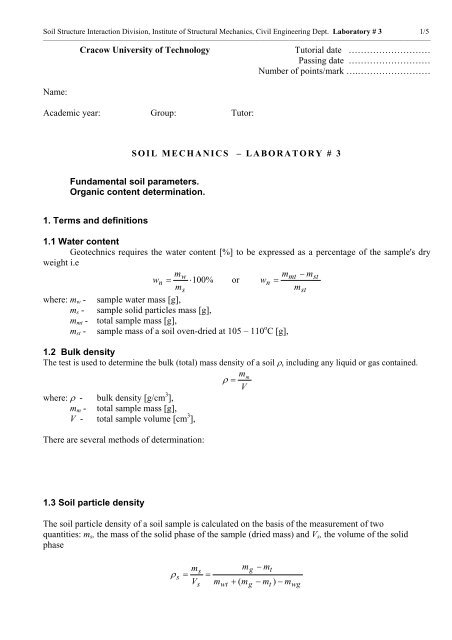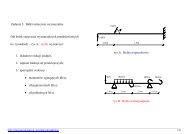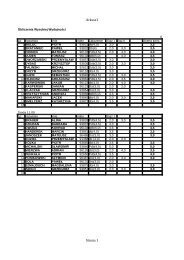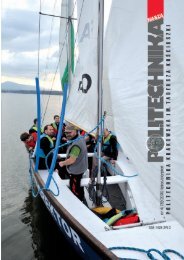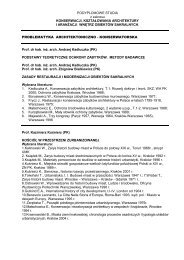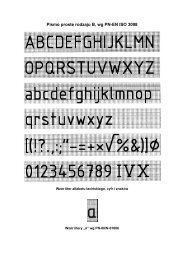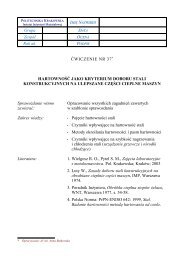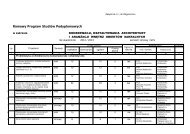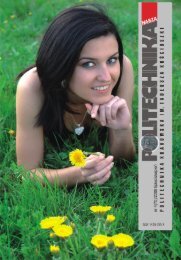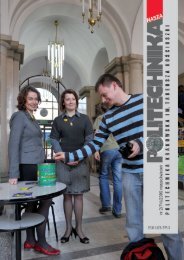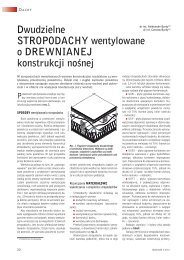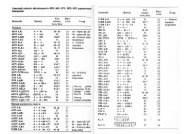Water content
Water content
Water content
Create successful ePaper yourself
Turn your PDF publications into a flip-book with our unique Google optimized e-Paper software.
Soil Structure Interaction Division, Institute of Structural Mechanics, Civil Engineering Dept. Laboratory # 3 1/5———————————————————————————————————————————————————Cracow University of TechnologyTutorial date ………………………Passing date ………………………Number of points/mark ….……………………Name:Academic year: Group: Tutor:SOIL MECHANICS – LABORATORY # 3Fundamental soil parameters.Organic <strong>content</strong> determination.1. Terms and definitions1.1 <strong>Water</strong> <strong>content</strong>Geotechnics requires the water <strong>content</strong> [%] to be expressed as a percentage of the sample's dryweight i.emwmmt− mstw n = ⋅100% or wn=msmstwhere: m w - sample water mass [g],m s - sample solid particles mass [g],m mt - total sample mass [g],m st - sample mass of a soil oven-dried at 105 – 110 o C [g],1.2 Bulk densityThe test is used to determine the bulk (total) mass density of a soil ρ, including any liquid or gas contained.where: ρ - bulk density [g/cm 3 ],m m - total sample mass [g],V - total sample volume [cm 3 ],There are several methods of determination:ρ =m mV1.3 Soil particle densityThe soil particle density of a soil sample is calculated on the basis of the measurement of twoquantities: m s , the mass of the solid phase of the sample (dried mass) and V s , the volume of the solidphaseρ =smVss=mwtm+ ( mgg− mt− m ) − mtwg
Soil Structure Interaction Division, Institute of Structural Mechanics, Civil Engineering Dept. Laboratory # 3 2/5———————————————————————————————————————————————————where: m s - soil particle mass [g],V s - soil particle volume [cm 3 ],m g - mass of a pycnometer with soil oven-dried at 105 – 110 o C [g],m wt - mass of a pycnometer with water [g],m wg - mass of a pycnometer with soil and water [g],m t - mass of a oven-dried pycnometer at 105 – 110 o C [g],1.4 Solid material densitySolid material density namely ρ d isIn practise the following formula is used:1.5 Porosity of soilPorosity of soil namely n [-] is ...1.6 Void ratio of soilVoid ratio of soil namely e [-] is...1.7 The formula linked the porosity and void ratio
Soil Structure Interaction Division, Institute of Structural Mechanics, Civil Engineering Dept. Laboratory # 3 3/5———————————————————————————————————————————————————2. The tests due to PN-88/B-04481.2.1 Determination of the water <strong>content</strong> of the soilEquipment and description of procedure:(The results are written on the separate sheet)2.2 Determination of the bulk (volume) density of the soil2.2.1 Determination of the volume density of the soil by a ring and/or a cylinderEquipment and description of procedure:(The results are written on the separate sheet)2.2.2 Determination of the bulk density of the soil by a hydrostatic lift in waterEquipment and description of procedure:(The results are written on the separate sheet)2.2.2 Determination of the bulk density of the soil by a hydrostatic lift in organic fluidEquipment and description of procedure:(The results are written on the separate sheet)2.3 Determinatio of the particle density of soil solid by pyknometer methodEquipment and description of procedure:(The results are written on the separate sheet)
Soil Structure Interaction Division, Institute of Structural Mechanics, Civil Engineering Dept. Laboratory # 3 4/5———————————————————————————————————————————————————3. Calculcation of the parameters obtained during the tutorials# Fomula Data Value1 Soil sample no.2 Soil classification3 <strong>Water</strong> <strong>content</strong>4 Bulk density5 Soil particle density6 Solid material density7 Porosity8 Void ratio(Comment the results)3. Determination of the organic <strong>content</strong> (PN)Organic material is made of carbon compounds, which when heated to high temperatures orchemically treated are converted to carbon dioxide and water.Organic <strong>content</strong> I om is a ratio of dry mass of organic compounds to the total mass of solidsTable 3 Soil classification due to organic <strong>content</strong> (PN-EN ISO 14688-2: 2005)SoilOrganic material <strong>content</strong>(≤ 2mm) % of dry massLow-organic 2 do 6Mid-organic 6 do 20Highly-organic > 20
Soil Structure Interaction Division, Institute of Structural Mechanics, Civil Engineering Dept. Laboratory # 3 5/5———————————————————————————————————————————————————Methods of determination of I om :3.1 Organic <strong>content</strong> determination (I om ) by H 2 O 2 treatmentEquipment and description of procedure:(The results are written on the separate sheet)3.2 Organic <strong>content</strong> determination by furnacing (I ż )Equipment and description of procedure:(The results are written on the separate sheet)
Soil Structure Interaction Division, Institute of Structural Mechanics, Civil Engineering Dept. Laboratory #3<strong>Water</strong> <strong>content</strong> (w) and bulk density (ρ) of the soil determinationwith a ring and/or a cylinderSoil classificationSample No.: ………...............Place........... …………………………… Soil name:: …………………..……………….….....…Other components: ……………….………………..…. CaCO 3 <strong>content</strong>: .………….. Colour:………………………………......<strong>Water</strong> <strong>content</strong>: .……………….Plasticity/ Particle shape.:……......…………………………………………………………….....Consistency …………………………...………….…….........………………………………………………………….………Overall mass (sample+cylinder): m<strong>Water</strong> <strong>content</strong> # 1Container no..…… <strong>Water</strong> <strong>content</strong> # 2Container no..……total mass with wet soil (g) mmt ……..…. - mst .……................. total mass with wet soil (g) mmt ……..…. - mst .…….................total mass with dry soil (g) mst........... - mass of container mt…... total mass with dry soil (g) mst........... - mass of container mt…...w = ( - / - )*100 = % w = ( - / - )*100 = %Bulk density ρ determination by a ringBulk density ρ determination by a cylinderOverall mass (sample+ring) : m mtρ = m m / V = ………………. g/cm 3 ρ = m m / V = ………………. g/cm 3Ring mass: m t .Cylinder mass:mtm t .Soil sample mass: m mSoil sample mass:m mRing volume: V = cm 3Cylinder volume: V = cm 3Calculations ρ =Soil classificationSample No.: ………...............Place........... …………………………… Soil name:: …………………..……………….….....…Other components: ……………….………………..…. CaCO 3 <strong>content</strong>: .………….. Colour:………………………………......<strong>Water</strong> <strong>content</strong>: .……………….Plasticity/ Particle shape.:……......…………………………………………………………….....Consistency …………………………...………….…….........………………………………………………………….………Overall mass (sample+cylinder): m<strong>Water</strong> <strong>content</strong> # 1Container no..…… <strong>Water</strong> <strong>content</strong> # 2Container no..……total mass with wet soil (g) mmt ……..…. - mst .……................. total mass with wet soil (g) mmt ……..…. - mst .…….................total mass with dry soil (g) mst........... - mass of container mt…... total mass with dry soil (g) mst........... - mass of container mt…...w = ( - / - )*100 = % w = ( - / - )*100 = %Bulk density ρ determination by a ringBulk density ρ determination by a cylinderOverall mass (sample+ring) : m mtρ = m m / V = ………………. g/cm 3 ρ = m m / V = ………………. g/cm 3Ring mass: m t .Cylinder mass:mtm t .Soil sample mass: m mSoil sample mass:m mRing volume: V = cm 3Cylinder volume: V = cm 3Calculations ρ =Tested by: …………………..…..…....….… Group …………….. date. ….………….………….Checked by: ……..……………………………………….…………date. ……………….………..


